Radioactive Material Packaging Market Research: 2032
The Global Radioactive Material Packaging Market Size was valued at $660.7 million in 2020, and is projected to reach $1.2 billion by 2032, growing at a CAGR of 5.1% from 2023 to 2032.
Containers used to transport and store radioactive materials safely are referred to as radioactive material packaging. Due to the unstable atomic nuclei that undergo radioactive decay and release ionizing radiation in the form of beta particles, gamma rays, and alpha particles, active material must be transported and stored with varying degrees of protection from the environment and from people. The packaging is made to prevent the radioactive materials from leaking out while also shielding users from the harmful effects of ionizing radiation.
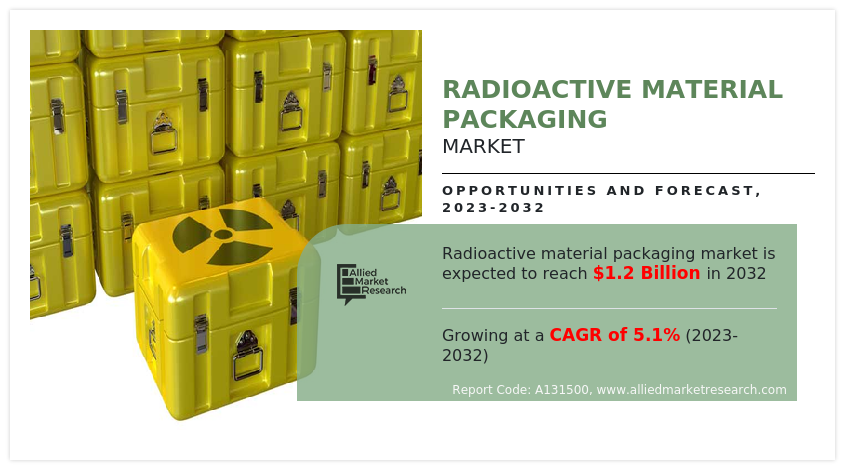
Market Dynamic
Several effective packaging options are available that offer safety issues while simultaneously leaving a less environmental footprint. Historically, numerous industries started using pails and drums extensively for the transportation of chemicals as the radioactive materials have various industrial advantages over similar materials. Hence, new solutions are filling a significant sustainability gap in the market.
Different industrial bulk containers, helps in storing more product per package which are collapsible, thus, reducing the amount of landfill space required and the cost of shipping. In addition, the use of radioactive materials in medicine for diagnostic imaging (e.g., PET and SPECT scans) and cancer treatment (radiation therapy) is on the rise. As healthcare technologies continue to advance, there is a corresponding need for safe and effective packaging to transport and store radioactive sources used in these applications. Moreover, the use of radioactive materials in scientific research and development applications, including nuclear physics and materials science, is growing. This necessitates specialized packaging solutions to ensure safety during experiments and transport.
However, radioactive material packaging is expansive is comparison with other types of packaging as radioactive materials are subjected to stringent safety regulations and guidelines to protect the health and safety of individuals and the environment. These regulations require specialized packaging materials and designs that can withstand various accident scenarios, such as drops, punctures, and fires. Compliance with these regulations often involves additional testing, certification, and quality control measures, all of which contribute to higher costs.
Moreover, radioactive materials emit ionizing radiation that can be harmful to humans and the environment. Effective packaging must include adequate shielding to reduce radiation exposure. This often involves the use of heavy, dense materials, such as lead or specialized radiation-absorbing composites, which can be costly.
Furthermore, several commodities, including food items along with oil & gas products saw a surge in price due to the Russia-Ukraine conflict. Due to supply chain interruptions, there are now more expensive shipping costs, fewer available containers, and less warehouse space. Since there have been delays in shipments and congestion, certain ports have been closed, and orders are being retracted, which influences industry and consumers globally. The decline in investor confidence has also increased stock market volatility. Economic instability has risen due to the strained commercial ties between Russia, Ukraine, and their different trading partners. Hence, all such factors have reduced export possibilities.
On the contrary, different packaging companies are launching hazardous material packaging systems that adhere to safety norms and guidelines. An individual class label, for instance, is required for each box carrying a risky or hazardous substance. In addition, for cargo vehicles carrying hazardous materials, tachographs that measure acceleration, time speed, and other vitals started getting mounted. Thus such developments are expected to offers profitable prospects for the growth of the radioactive material packaging market.
Segmental Overview
The radioactive material packaging market is segmented into material , product , and types. The material in the study includes plastic, metal, and others. Based on product, the market is divided into drums, intermediate bulk containers (IBCs), pails, bottles, and others. Based on types, the market is divided into type A, type B and others. Region wise, the market is analyzed across North America (the U.S., Canada, and Mexico), Europe (Germany, France, Italy, Spain, and rest of Europe), Asia-Pacific (China, Japan, South Korea, India, and rest of Asia-Pacific), and LAMEA (Latin America, the Middle East, and Africa).
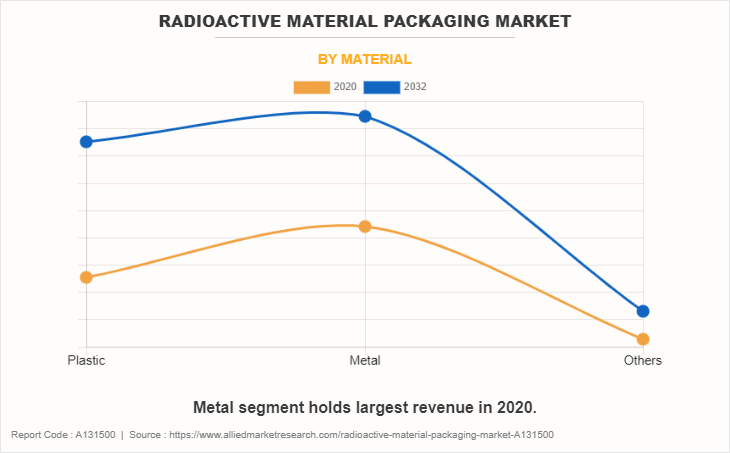
By Material :
By material type, the radioactive material packaging market is segmented into plastic, metal, and other. When compared to other materials like metal and glass, plastics are lighter. This is then anticipated to support the market's expansion. Additionally, the majority of the market's growth is anticipated to come from developing nations in Asia-Pacific and Africa. In addition, metal is used for production of cans and bottles for packaging of alcoholic and non-alcoholic beverages, food, and other contents. Furthermore, other material types include corrugated is used as a type of secondary packaging system for hazardous material that is entirely made up of corrugated material. Metal is expected to exhibit the largest revenue contributor during the forecast period. Plastic is expected to exhibit the highest CAGR share in the applications of segment in the radioactive material packaging industry during the forecast period.
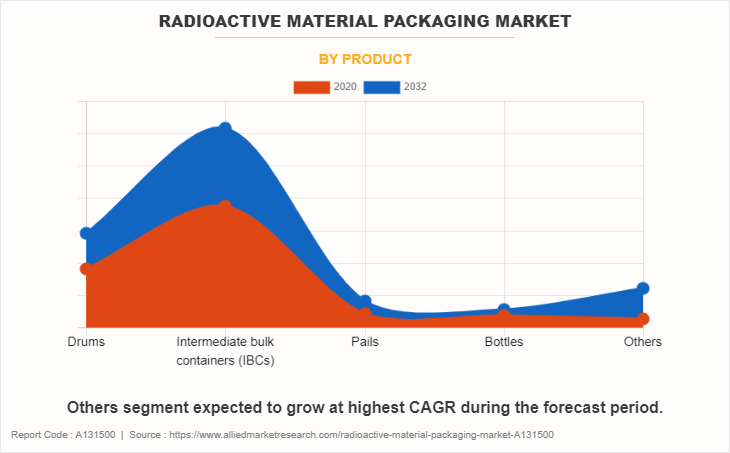
By Product :
By product type, the radioactive material packaging market is segmented into drums, intermediate bulk containers (IBCs), pails, bottles, and others. Drums are commonly used for the storage and transportation of hazardous as well as non-hazardous goods. In addition, IBCs are eco-friendly packaging due to their usability and recyclable nature is expected to boost the growth of the market. Furthermore, Pails are used in various industries such as chemical and pharmaceuticals for shipping and transportation. Moreover, Bottles are manufactured using plastic (mostly PET), glass, paperboard, and metals.
They are convenient to use as they are easy to carry, resealable, and light in weight. The intermediates bulk containers (IBCs) segment is expected to be the largest revenue contributor during the forecast period, and the others segment is expected to exhibit the highest CAGR share in the product segment during radioactive material packaging market forecast period.
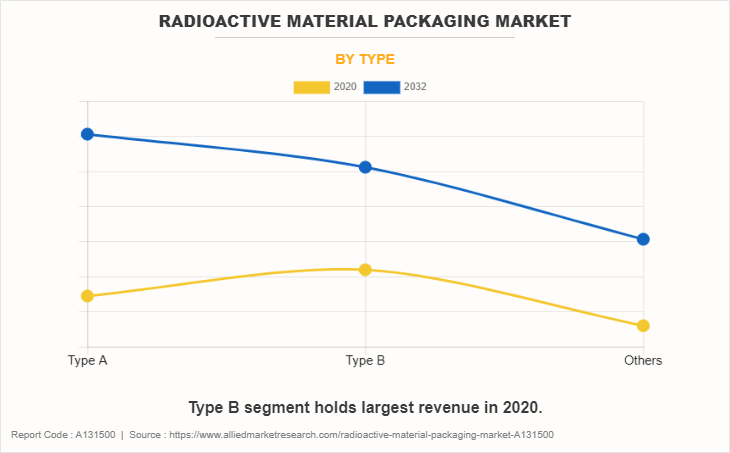
By Type:
The radioactive material packaging is divided into Type A, type B and others. Owing to the increased usage of radioactive material in various industries such as research industries, medical uses, and industrial processes. In addition, Type B packaging is designed and tested to meet more restraint safety requirements compared to type A packages. due to the increased usage of radioactive materials in many industrial uses, including scientific research, industrial radiography specialization techniques, and industrial applications. Type b segments are expected to be the largest revenue contributor during the forecast period, and the type a segment is expected to exhibit the highest CAGR share in the propulsion system segment in the radioactive material packaging market during the forecast period.
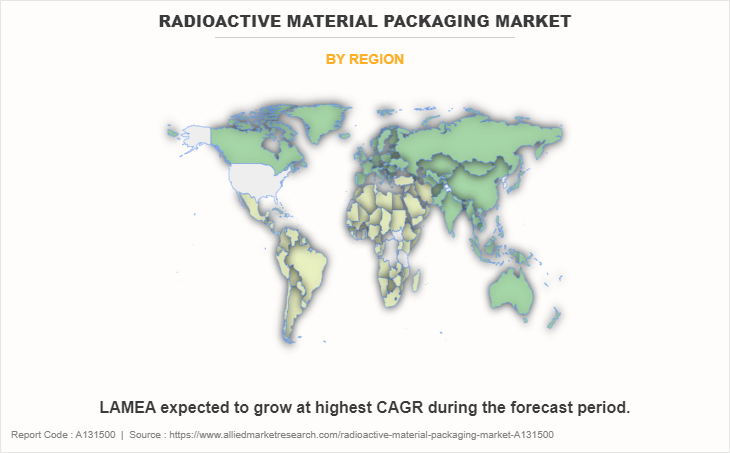
By Region:
The radioactive material packaging market is analysed across North America, Europe, Asia-Pacific, and LAMEA. In 2022, Europe held the highest revenue in radioactive material packaging market share. And LAMEA is expected to exhibit the highest CAGR during the forecast period.
Competition Analysis
The key companies profiled in the radioactive material packaging market report include, Strategic Packaging Systems, General Plastics, Croft Limited, Waste Control Systems (U.S.), Kvark Ltd., Air Sea Containers, Waste Control Systems, ATB Group S.p.A., Sosny Research and Development Company, and PerkinElmer. Major companies in the market have adopted acquisition, product launch, business expansion, and other strategies as their key developmental strategies to offer better products and services to customers in the radioactive material packaging market .
Key Benefits For Stakeholders
- This report provides a quantitative analysis of the market segments, current trends, estimations, and dynamics of the radioactive material packaging market analysis from 2020 to 2032 to identify the prevailing radioactive material packaging market opportunities.
- The market research is offered along with information related to key drivers, restraints, and opportunities.
- Porter's five forces analysis highlights the potency of buyers and suppliers to enable stakeholders make profit-oriented business decisions and strengthen their supplier-buyer network.
- In-depth analysis of the radioactive material packaging market segmentation assists to determine the prevailing market opportunities.
- Major countries in each region are mapped according to their revenue contribution to the global market.
- Market player positioning facilitates benchmarking and provides a clear understanding of the present position of the market players.
- The report includes the analysis of the regional as well as global radioactive material packaging market trends, key players, market segments, application areas, and Radioactive Material Packaging Market Growth strategies.
Radioactive Material Packaging Market Report Highlights
| Aspects | Details |
| Market Size By 2032 | USD 1.2 billion |
| Growth Rate | CAGR of 5.1% |
| Forecast period | 2020 - 2032 |
| Report Pages | 220 |
| By Type |
|
| By Product |
|
| By Material |
|
| By Region |
|
| Key Market Players | Waste Control Systems, Croft Limited, Strategic Packaging Systems LLC, PerkinElmer, Air Sea Containers, Waste Control Systems, Sosny Research and Development Company, Kvark Ltd., General Plastics, ATB Group S.p.A. |
Analyst Review
Growing industrialization is leading to growth in demand for radioactive material packaging utilized by various end-user industries such as chemical, pharmaceutical, oil & gas, and others. Radioactive materials are valuable for numerous scientific, medical, industrial, and research applications. Thus effective packaging is required in order to safely transport radioactive material from one location to another. This, is growing the focus on the usage of effective containers and vessels. However, particles emitted during the leakage stages of container glass are much more harmful as they are smaller in size and can result in a variety of health problems once they enter the respiratory system. Hence, containers should be properly checked before transporting them. On the contrary, the nuclear energy sector is experiencing a resurgence in certain regions in order to reduce carbon emissions and meet the growing energy demands. Hence, this will require packaging solutions in order to safely store and transport the nuclear fuel along with other radioactive materials.
The global radioactive material packaging market was valued at $660.7 million in 2020, and is projected to reach $1,161.6 million by 2032, registering a CAGR of 5.1% from 2023 to 2032.
The base year considered in the Radioactive material packaging Market is 2022.
The report for radioactive material packaging market doesn’t provides Value Chain Analysis, but if there is a requirement for the same, it could be added as an additional customization.
Based on type, type B segment is expected to be the most influencing segment in the radioactive material packaging.
Based on the material, in 2022, the metal segment generated the highest revenue, and plastic is projected to grow at a CAGR of 6.6% from 2023 to 2032.
The report contains an exclusive company profile section, where leading 10 companies in the market are profiled. These profiles typically cover company overview, geographical presence, and market dominance (in terms of revenue).
The market value of Radioactive material packaging Market is $ 713.2 million in 2022.
Loading Table Of Content...
Loading Research Methodology...



